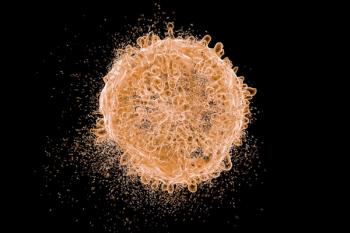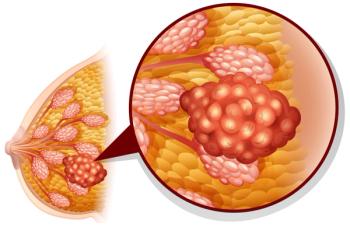
- ONCOLOGY Vol 11 No 6
- Volume 11
- Issue 6
University of Minnesota Researchers Find Evidence of Genetic Link to Breast Density
Researchers at the University of Minnesota Cancer Center have found evidence that mamographic breast density, a measure of the relative proportions of fat, connective tissue, and glandular epithelial tissue in the breast that is a strong, independent
Researchers at the University of Minnesota Cancer Center have foundevidence that mamographic breast density, a measure of the relative proportionsof fat, connective tissue, and glandular epithelial tissue in the breastthat is a strong, independent predictor of breast cancer risk, is geneticallyinfluenced. The study, published in the April 16th Journal of the NationalCancer Institute, also suggests that 12% of the population has a geneticmutation that results in a breast density twice that of women without themutation.
"It isn't known how high breast density increases the risk of breastcancer," said lead investigator Thomas Sellers, associate professorof epidemiology and associate director of the Cancer Center. "Butthe risk is considered second only to the risk incurred by mutations inthe BRCA1 and BRCA2 genes."
The researchers obtained routine mammograms and a variety of health-relateddata from 1,370 women from 258 different Minnesota families. The studypopulation included 65 mother-daughter pairs and 275 sister-sister pairs.All of the women were related, either genetically or by marriage, to anoriginal group of 544 breast cancer patients seen at the University ofMinnesota between 1944 and 1952. Sellers and colleagues are studying thesefamilies as part of the Breast Cancer Family Cohort study.
Breast Density Partly Modifiable
Sellers says that the study is significant because the researchers wereable to separate out other risk factors, such as waist-to-hip ratio, physicalactivity, hormone replacement therapy, and number of live births, to detecta Mendelian dominant inheritance pattern (a pattern where only one copyof the mutated gene is necessary to transfer the trait to offspring). Theywere unable, however, to completely eliminate the possibility of a recessivepattern, which would require more than one copy of a gene to produce atrait. However, if breast density is, indeed, controlled by a dominantgene, about 12% of the population would be expected to carry a form ofthe gene that results in a breast density about twice that of the restof the population. "The good news is that while breast density riskfactor is partly genetic, it's also shaped by the environment, and so canbe modified," Sellers said.
In previous studies, Sellers and colleagues have reported on potentialrisk factors for breast cancer, including waist-to-hip ratio, fat in thediet, and the connection between breast cancer in women and prostate cancerin men. These finding stem from the Iowa Women's Study, an ongoing healthstudy of more than 40,000 women in Iowa.
Articles in this issue
over 28 years ago
Use of Adjuvent Analgesics Profiled at Pain Conferenceover 28 years ago
Chromosomal Changes Linked to Family History of Lung Cancerover 28 years ago
Bacterial Infection in Patients With Cancer: Focus on Preventionover 28 years ago
Docetaxel in Combined Modality Therapy for Breast Cancerover 28 years ago
Role of Diet in Cancer Hard to Study, Expert Saysover 28 years ago
Guidelines for the Early Referral of Patients to Cancer Specialistsover 28 years ago
New Drugs May Brighten Ovarian Cancer Pictureover 28 years ago
Researchers Hope Function of BRCA1 Gene Holds Key to New Treatmentsover 28 years ago
Research Points to Effectiveness of Brachytherapy in Early ProstateNewsletter
Stay up to date on recent advances in the multidisciplinary approach to cancer.





